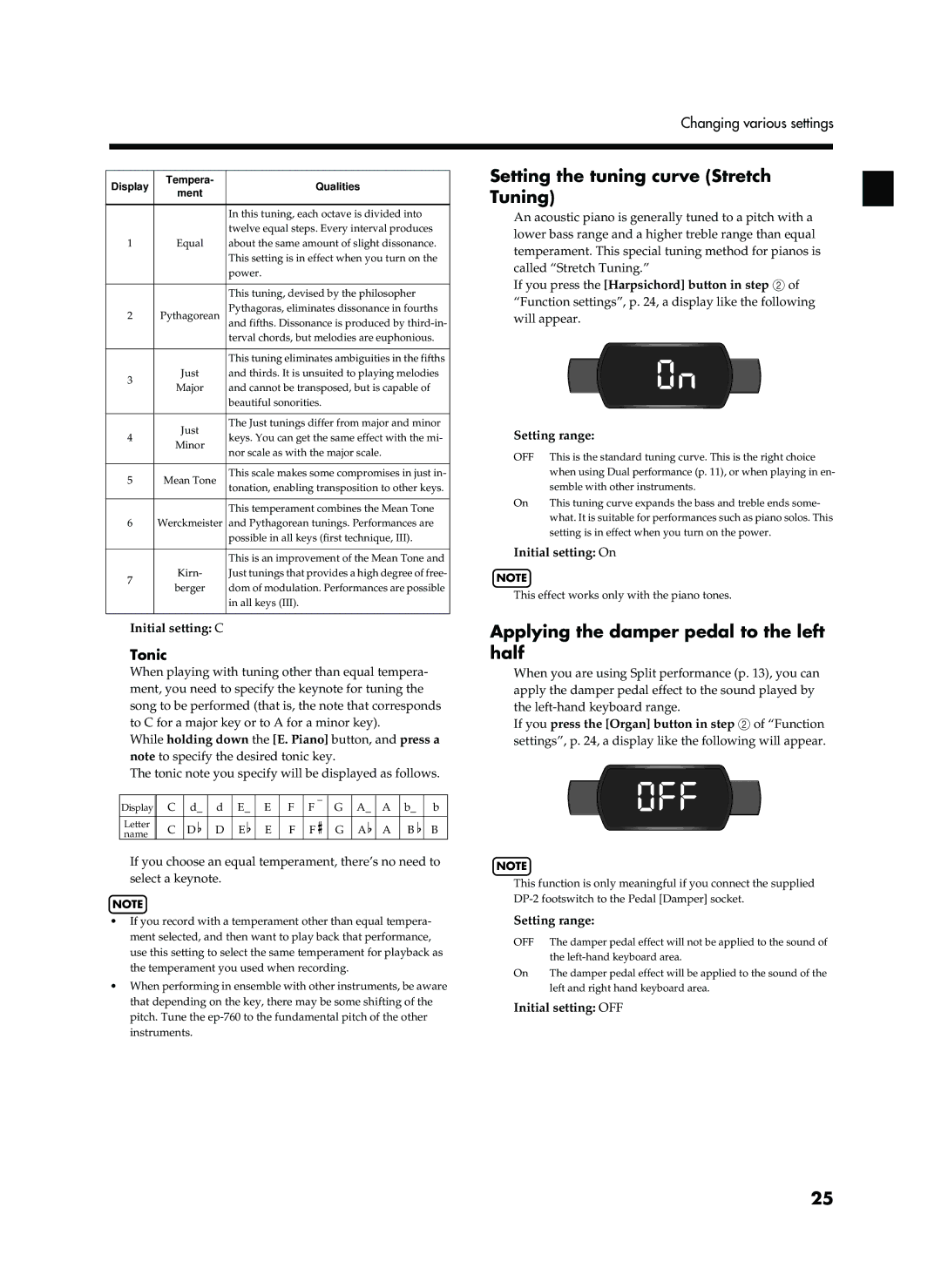
Changing various settings
Display | Tempera- | Qualities | |
ment | |||
|
| ||
|
|
| |
|
| In this tuning, each octave is divided into | |
|
| twelve equal steps. Every interval produces | |
1 | Equal | about the same amount of slight dissonance. | |
|
| This setting is in effect when you turn on the | |
|
| power. | |
|
|
| |
|
| This tuning, devised by the philosopher | |
2 | Pythagorean | Pythagoras, eliminates dissonance in fourths | |
|
| and fifths. Dissonance is produced by | |
|
| terval chords, but melodies are euphonious. | |
|
|
| |
|
| This tuning eliminates ambiguities in the fifths | |
3 | Just | and thirds. It is unsuited to playing melodies | |
Major | and cannot be transposed, but is capable of | ||
| |||
|
| beautiful sonorities. | |
|
|
| |
| Just | The Just tunings differ from major and minor | |
4 | keys. You can get the same effect with the mi- | ||
Minor | |||
| nor scale as with the major scale. | ||
|
| ||
|
|
| |
5 | Mean Tone | This scale makes some compromises in just in- | |
tonation, enabling transposition to other keys. | |||
|
| ||
|
|
| |
|
| This temperament combines the Mean Tone | |
6 | Werckmeister | and Pythagorean tunings. Performances are | |
|
| possible in all keys (first technique, III). | |
|
|
| |
|
| This is an improvement of the Mean Tone and | |
7 | Kirn- | Just tunings that provides a high degree of free- | |
berger | dom of modulation. Performances are possible | ||
| |||
|
| in all keys (III). | |
|
|
|
Initial setting: C
Tonic
When playing with tuning other than equal tempera- ment, you need to specify the keynote for tuning the song to be performed (that is, the note that corresponds to C for a major key or to A for a minor key).
While holding down the [E. Piano] button, and press a note to specify the desired tonic key.
The tonic note you specify will be displayed as follows.
|
|
|
|
|
|
|
|
|
|
|
|
|
|
| |
Display | C | d_ | d | E_ | E | F | F | G | A_ | A | b_ | b | |||
|
|
|
|
|
|
|
|
|
|
|
|
|
|
| |
Letter | C | D | D | E | E | F | F | G | A | A | B | B | |||
name | |||||||||||||||
|
|
|
|
|
|
|
|
|
|
|
|
|
| ||
If you choose an equal temperament, there’s no need to select a keynote.
NOTE
•If you record with a temperament other than equal tempera- ment selected, and then want to play back that performance, use this setting to select the same temperament for playback as the temperament you used when recording.
•When performing in ensemble with other instruments, be aware that depending on the key, there may be some shifting of the pitch. Tune the
Setting the tuning curve (Stretch Tuning)
An acoustic piano is generally tuned to a pitch with a lower bass range and a higher treble range than equal temperament. This special tuning method for pianos is called “Stretch Tuning.”
If you press the [Harpsichord] button in step B of
“Function settings”, p. 24, a display like the following will appear.
| 0n |
Setting range: | |
OFF | This is the standard tuning curve. This is the right choice |
| when using Dual performance (p. 11), or when playing in en- |
| semble with other instruments. |
On | This tuning curve expands the bass and treble ends some- |
| what. It is suitable for performances such as piano solos. This |
| setting is in effect when you turn on the power. |
Initial setting: On
NOTE
This effect works only with the piano tones.
Applying the damper pedal to the left half
When you are using Split performance (p. 13), you can apply the damper pedal effect to the sound played by the
If you press the [Organ] button in step B of “Function settings”, p. 24, a display like the following will appear.
0ff
NOTE
This function is only meaningful if you connect the supplied
Setting range:
OFF | The damper pedal effect will not be applied to the sound of |
| the |
On | The damper pedal effect will be applied to the sound of the |
| left and right hand keyboard area. |
Initial setting: OFF
25
